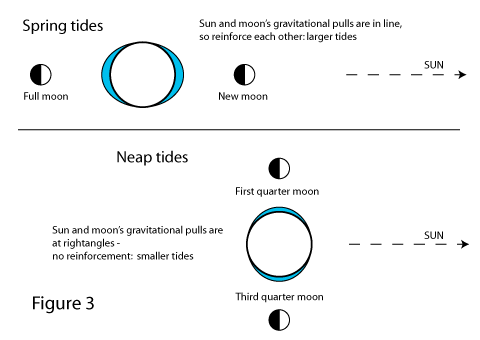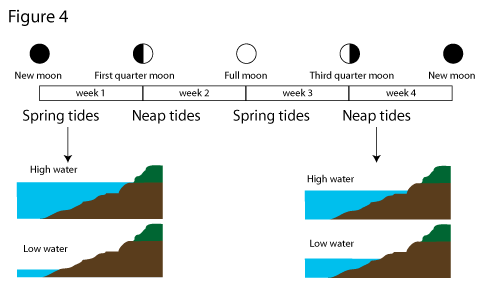2.1 Explanation of Tides
What Causes the Tides?
The earth’s tides are caused by the gravitational pull of the moon and the sun. The pull of gravity is what keeps the earth and moon revolving round one another, and what keeps this pair revolving round the sun.
Gravity is stronger the closer you get to the object causing it. With the moon, which is quite close to us, this is significant; at the side of the earth which is closest to the moon its gravitational pull is stronger, and at the opposite side of the earth the moon’s gravitational pull is correspondingly weaker.
On land, nothing can really move in response to this difference is gravitational force, but water can move. What it actually does is form two bulges in the oceans: one on the side facing the moon and the other on the opposite side as shown in figure 1 (we're looking down on the earth from above the north pole).

The one on the side closest to the moon is caused because the stronger gravitational pull attracts the water. The one on the furthest side from the moon side is caused because the centrifugal force (which here is stronger than the gravitational force) throws the water outwards as the earth rotates around the moon (remember, they rotate around each other, even though the earth is much closer to the centre of this rotation). Note that the figure is not to scale.
The earth also spins on its axis. It takes 24 hours for each point on the earth to get from one noon (i.e. facing towards the sun) to the next noon. It takes slightly longer (about 24 hours 50 minutes) between successive lunar noons, because the moon moves with respect to the sun - it rises a little later each day.

In this 24 hour 50 minute period each place will experience the forces that cause the two tidal “bulges” mentioned above, i.e. in general, two high tides and two low tides.
The typical pattern is shown in figure 2, where once again we are looking down on the earth from above the north pole. (To make the numbers simpler, I've shown a 24 hour cycle). Note the two high tides and two low tides in the 24 hour period.
This tidal pattern is called semi-diurnal, meaning “every half day”. High tides are about 12 hours apart.
Another way of looking at it is as a "system" undergoing a regular cycle of forces. Any point on the earth’s surface experiences the full cycle tidal forces from the moon in each 24 hour 50 minute period. This regularly changing set of tidal forces causes the water to oscillate. This is like any object or structure - solid or fluid - which is made to oscillate by a force which has a steady frequency. If for example, you fill a basin with water and then move your hand back and forth in it to a regular rythm, quite an impressive oscillation can build up. Such a system will oscillate at the same frequency as the forces applied to it.
Note also that in figure 2 the water level changes smoothly in response to the forces. This is typical of oscillations and waves of various kinds. There are no sudden jerky movements (it is called harmonic motion).
Complex Tidal Patterns
Life would be very simple if the earth was covered with a single ocean of even depth. Then the tide everywhere would be like figure 2. But the earth is irregular, oceans vary in depth and each ocean basin has it's own natural frequency for oscillations, and also water has to flow in and out of narrow gaps between land masses in order to get to where the high tide is.
So the pattern of the tidal oscillation is quite complicated and differs depending on where you are.
In some places the ocean oscillates so that the two daily tides are quite different in size, and in some places this effect is so pronounced that there is only one high tide per day (diurnal tides).
In most European coastal areas the tide is semi-diurnal, but some parts of the English south coast have a tidal pattern which is very different from the simple harmonic pattern in figure 2. This is usually because of the way the water flows round headlands and in and out of complex waterways like the Solent. You can get double high tides or prolonged stands - periods when the tide does not rise or fall.
But despite that, the system behaves in a predictable way. Wherever you are, the pattern of tides - however complex - will repeat itself in time with the forces that are causing it. You could imagine holding a tray of water with a scale model of the English Channel on it. You tip it slowly one way and the other with a regular rhythm. The water in different places won’t all move at exactly the same time; there will be a delay as the water pushes up the channel and swirls round the corners. But the motion, however complicated, will repeat itself exactly in time with the tipping of the tray.
Spring Tides and Neap Tides
 Both the moon and the sun cause a tidal effect. The moon’s is 2.5 times greater than the sun because the moon is closer. When the sun, moon and earth are in line, the tidal effect is stronger because the sun and moon’s tidal forces are combined; the sun and the moon’s “double bulge” effect reinforce each other, an this causes bigger tides known as Spring Tides.
Both the moon and the sun cause a tidal effect. The moon’s is 2.5 times greater than the sun because the moon is closer. When the sun, moon and earth are in line, the tidal effect is stronger because the sun and moon’s tidal forces are combined; the sun and the moon’s “double bulge” effect reinforce each other, an this causes bigger tides known as Spring Tides.
This happens when the moon is full (opposite side of the earth to the sun) or new (same side as the sun), as shown in figure 3. It takes a couple of days for this to produce the largest tides, so they occur a couple of days after the new and full moons.
The smaller tides that occur half way between new and full moons are called Neap Tides.
Figure 4 shows the sequence of spring and neap tides according to the phase of the moon. It takes 4 weeks from one full moon to the next, so spring tides happen every 2 weeks. The size of the tide gradually decreases over the course of one week to become neap tides, then gradually increses again. 
Other factors you need to be aware of are:
• the tides don’t always repeat after exactly 24 hours 50 minutes, because the sun’s effect changes the timing of the tides - sometimes it's less and sometimes it's slightly more
• some spring tides are larger than others (and some neaps smaller) because the earth and moon are not in circular orbits. The orbits are elliptical, so at some times during the year the earth is closer to the sun, causing larger tides.
